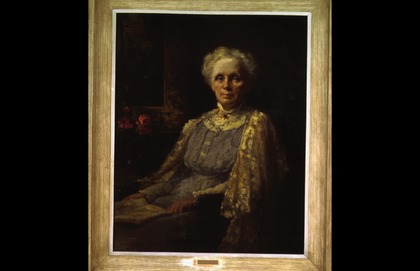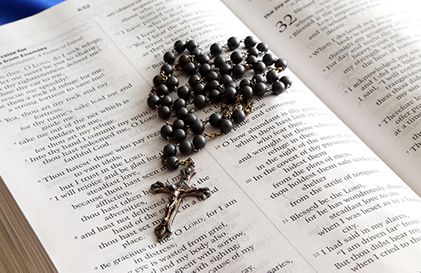Until the 1960s, the Canadian College followed the strict norms of the Sacred Congregation of Seminaries and Universities regarding the life of the Roman seminaries and colleges. The College, like some of its Roman counterparts, was meant to be a community of priests in higher education, in the pontifical Roman universities. Colleges were not hotels or pensioni for travelling priests, as the College was reminded on at least one occasion. The Secretary of the Sacred Congregation of Seminaries and Universities noted that this practice at the Canadian College in 1920 caused "the discipline of the college students to be perturbed." Visitors should be limited to bishops and their entourage. The residents were to obey the general rule of the establishment and the rector, who was helped by the bursar and the secretary—the three were the directors of the College—in the administration of the institution. In turn, the rector of the College answered to the Superior of the Canadian Province of the Sulpicians, located in Montreal, and through him to the Superior General of the Association in Paris. For temporal or business matters, the College depended on the Seminary of Montreal. The Superior General of Saint-Sulpice had the same authority over the College as he had over other seminaries run by the Sulpicians, and in particular that of Montreal. The Procureur de St. Sulpice was responsible for all matters between the College and the Holy Father or between the College and the Sacred Congregation of Propaganda Fide.
The residents of the College or "house" belonged to a rank (rang), according to their ministerial orders, the dignity of their benefice, the degree from a sacred faculty, or seniority in the house. All priests, no matter the rank, were bound by the Rule of the College. The first General Rule was finalized in November 1888 and was very much concerned with the daily prayer schedule of the College. The morning bell would ring at 5 a.m. The students took turns in carrying a large bell through the student floors, ringing it to wake everyone from slumber. Morning prayer would commence at 5:30, followed by a celebration of the Mass by the community. In the Roman custom, the chapel had no pews, but each priest had a chair and a priedieu. This was also the moment for the sacrament of confession. Only the directors of the College heard confession, according to the strict Roman norms. It was understood that the student priests would confess themselves once a week. Each priest then celebrated his own Mass in the chapel and at the time and altar assigned to him. Seven priests would celebrate at separate altars at the same time. Seven other priests would serve Mass, one for each of the celebrants, and then the original celebrants would serve Mass for the priest who had just been their server. Other priests would celebrate in nearby churches. The students' day of study was thus guided by prayer and reflection. They would recite matins, lauds, and the rosary and would visit the Blessed Sacrament at opportune moments during the day.
Breakfast would normally commence at 7:30, on a first come, first served basis. Coffee, sugar and milk were ready for the students, on a table, and they could rush off for classes when they wished. Classes at the Roman universities in the early years were from 8 a.m. until 10 a.m. As the College was close to the Roman universities, the neighbouring streets were teeming with clerics rushing to classes.
At noontime, the Angelus bell would call the priests to silence, and at 12:15, they would find themselves in the chapel, on their knees, reading a chapter of the New Testament and doing an examination of conscience as the rector read a passage from the 17th century Sulpician, Louis Tronson's Examens Particuliers. A second bell at 12:30 signalled lunch. Certainly until the First World War and perhaps beyond that, students sat at four long tables according to seniority in the College, so that a newly ordained priest who had been in the College for a year would have precedence over a newly arrived priest who had been ordained for 10 years.
Students would take a break at 1 p.m. in the common room, although one could also go to one's room for a smoke as quite a number of the priests in the mid-1890s had the habit of smoking a pipe. Students at the Propaganda would be back in class at 1:30 p.m., and classes would end an hour and a half before sundown so that students and professors could take their evening stroll or Roman passeggiata.
In the early years of the College, there was a plan to have some professors at the pontifical colleges reside at the Canadian College to assist the students in their studies. Reverend Luigi Chiesa, a professor of dogmatic theology at the Roman Seminary, would visit the College three times a week to do review lessons with the priests. It was Archbishop (later Cardinal) Francesco Satolli, soon to become Apostolic Delegate to the United States, who asked the Sulpicians to rely on Chiesa for this task.
At 7 p.m. the young priests would assemble for a common spiritual reading, for one half hour, followed by dinner and leisure time. Canadian students found it difficult to have supper at such a late hour. The Abbé Cimon noted in 1892 that for "some of the Canadians the supper hour is the limit for them." Lunch and supper were normally short affairs. There was free time at 8 p.m., when students met in the common room again. Some played billiards, others joined together for dominoes, while yet others preferred to go out for an evening stroll and conversation. There was a piano in the common room and, at times, the students would sing together. The day would end with night prayer at 8:15, and at 8:45 p.m. with the later daylight in May and June. The long silence began at 9 p.m. The need for a rule of silence in the house went back to 1895, during a visit of M. Captier to the College. It was then that the directors decided to disallow any visits to another student's room after night prayer.
All the students in the College were expected to maintain silence from after night prayer until the end of lauds, or morning prayer, throughout the College, even during mealtimes, when one of the priests, according to his rank, would read a passage. Some of the books they read were about Cardinal Charles Lavigerie's (the founder of the White Fathers of Africa) and Eug ène de la Gournerie's 1843 work, Rome Chrétienne, in order to acquaint the students with Rome's Christian heritage. When the Abbé Casgrain visited there in early 1892, the students were reading these books as well as Monsignor Philippe Gerbet's Esquisse de Rome Chrétienne, as the students were preparing for a visit to the Roman monuments. M. Captier advised that reading be done for only the first half of the mealtime in order not to tire out the students. From the mid-1890s, the reading was done in Italian, a few months into term, in order to help the students acquire the language. The book was passed around to seven or eight of the students during the meal, but was read by only one of them. In the early years, the directors advised students to read the Abbé Louis Branchereau's Politesse et convenances ecclésiastiques, what we might call a book of etiquette for the clergy, to help the young priests correct their "numerous faults." Once a month, the rule of the house was read aloud to remind the College members of the schedule and guidelines of the establishment.
The priests were not allowed to leave the College without the permission of the Superior (the rector) or his substitute. One student was refused permission to go see the fireworks in Rome one evening in 1892. He went anyway, and the case was taken up by the directors of the College in their formal meeting. Students were to dress in clerical attire both within the College and in the city. Some priests apparently had not been observing this practice and the directors saw the need in 1904 to inform their bishops. Food consumption was not allowed in the rooms or elsewhere in the College, neither for oneself nor for guests. Nor were priests to have meals or snacks outside the College. In 1927, M.R. Labelle, Superior of the Sulpicians in Canada, noted on one of his visits to Rome that some of the Canadian priests were snacking in restaurants in the afternoon. Even studying was done with the approbation of the Superior; in other words, one needed permission to study outside the normal hours. And finally, a College member was required to do a spiritual retreat upon entry into the College and was advised to undergo these exercises annually. In the early years, students were expected to take vacations either in Lugano or at the seminary of Issy, near Paris. They needed written permission from their bishop to take vacations elsewhere if they were not returning to their diocese. They maintained a disciplined lifestyle while on vacation, wearing a soutane and not going to the theatre. In the late 1930s, the Sacred Congregation of Seminaries and Universities complained that students from ecclesiastical colleges in Rome were frequenting the beach in nearby Ostia and "were even going bathing in public."
Although the priests were not permitted snacks, they were well nourished in the College under the care of the kitchen staff, who reported directly to the bursar in the early years and strove to provide a varied meal plan for the residents. A typical breakfast menu in the 1920s included coffee, milk, bread and butter. For lunch, a variety of soups were offered during the week—tomato, potato, vegetable, velouté—in such a way that "the students cannot say: on such and such a day we are going to have that soup." The second course was a choice of two meat dishes with a vegetable or noodle side dish, followed by dessert and cheese. For supper, the priests were offered a variety for the main course over a week—beef, veal or lamb roast, pot roast—and on feast days, quelque chose en plus. For the usual feast days such as All Saints Day, they could expect a sweet plate, cheese and coffee for lunch, and cheese for supper. On some of the other feast days, they would receive the same fare as the directors and visitors. This was the case on November 21, the Presentation of the Blessed Virgin Mary, as it was the feast day of the Sulpicians. On that day, all members of the College were offered beef filet, fried sweetbreads, peas and roasted turkey with salad for lunch. Dessert followed, with trifle, cheese, grapes, pears, coffee and a bottle of fine wine for each table, although this was a slightly later development. Normally, fruit was served. "There is no talk of pudding, any pastries, jams or other such sweets," wrote one priest. To supper was added cheese, biscuits and jam. There were other similar sumptuous servings for the feasts of Saint John the Evangelist (December 27), the Circumcision of Our Lord (January 1), the Epiphany (January 6), the Presentation of Our Lord (February 2), Shrove Tuesday, Saint Joseph (March 19) and Easter Sunday.
Table service at lunchtime was done according to the French custom, in that the plat de resistance and other dishes were presented to each student, who would then serve himself. Fresh plates were placed in front of the students during the meal, whereas they held on to their knives and forks. Bread and wine was served at every meal, as was the Roman custom. As the Abbé Cimon wrote, Italians "find it hard to believe that water and tea should be the norm at noontime or in the evening, in a word that one can live in a land where there is no wine."
In the 1930s, it seems that the menu became more firmly French with a Canadian twist. On November 11, 1938, on the 50th anniversary of the College, the banquet featured filets de sole chevali ère, veal cutlets à la princi ère, roast guinea hen, a maple parfait and Canadian sweets. By 1950, the College had moved decidedly in the direction of Canadian tastes.
Starting in the period of M. Léger's direction, the firm of J.S.A. Bernard, suppliers in Montreal, furnished the College with all sorts of prepared foods from Canada. This was in response to the economic crisis in post-war Italy and Europe in which foods and consumer items were in short supply. In May 1947, in preparation for his arrival as rector of the College, Monsignor Paul-émile Léger, writing from Salaberry-de-Valleyfield as Vicar General of the diocese, noted that a considerable quantity of canned foods would have to be purchased and shipped from Canada. He observed that all the Sulpician missionaries leaving for Japan were required to purchase one year's food supply—about a ton—so that this was possible for those going to Rome as well, and would allow for a smoother organization of the kitchen in the first year of post-war operations. In 1947, the College decided to import cereals, flour, chocolate, sugar, coffee, tea, cheese, concentrated milk, preserved meats and fish, cleaning soap and hand soap from home. This included canned Campbell soups, jams and jellies, corn syrup, maple butter, grape juice, relish, pickles, Dream Whip, cans of mixed vegetables, cream corn, chop suey beans, cranberries, or canned tomatoes. It might be that students and directors longed for food from back home, not only items unavailable in Italy (chop suey, relish or maple butter) but also Canadian versions of easily accessible foods such as canned tomatoes or soups. The custom of supplying foods from Montreal seems to have continued at least until 1970.
The College was built to house up to 50 students normally, even if that complement was filled for only a few years in the 86 years that the College was located on Via delle Quattro Fontane. From a financial point of view, these numbers mattered in the overall budget of the establishment. A student's boarding fees were steep and were normally covered by his bishop, as he was sent to Rome by his ordinary to pursue further studies. Take the example of Reverend James Treacy, who emigrated to Ontario at a very young age and studied in a number of colleges in Ireland and Canada before enrolling at the university at Propaganda Fide for the diocese of Toronto. His bishop wanted Treacy writing in Latin and Italian as he might be useful for his correspondence with the Vatican offices in the future. Father Treacy's fees at the College in 1889 came to 750 Italian lire for the year, but there were many additional charges: 25 lire for lighting in his bedroom, about the same for books, 95 lire for clothing, 450 lire for vacations and travel (the students went on vacations together in the Italian countryside in the summer) and 10 lire for medicine. In 1900, one Canadian dollar was worth between 4 and 5 lire. Even with a full house, the student fees did not cover the expenses of the institution and the Sulpicians found themselves subsidizing the College throughout its history.
Students reacted very differently to Rome and to college life, depending on their outlook. For some priests it was difficult to adjust to the new rhythms and foods of Italian life. Going back to school might have seemed a luxury, but it also meant an adjustment to one's schedule and adapting to new ways of doing things. Let us recall that priests did not choose to go to Rome; they were sent there by their bishops. It must have been a surprise for many of them to return to full-time formal studies. The Abbé Cimon, who was a professor at the Seminary of Chicoutimi and attended the College in 1891-92, related that "I could not keep from having a sense of astonishment from time to time, at the age of 36 years and after 10 years of pastoral ministry, to find myself sitting behind a student's desk." However, "the orderly and studious life of the Canadian College [was] an agreeable oasis" compared to the work of the parish or teaching.
On the other hand, some priests loved the Eternal City, and though they had to work hard at attending classes, studying and preparing a thesis, they also had the wonderful opportunity to see the city, living close to its heart. The Abbé Cimon fondly described his strolls in his neighbourhood and through the historical centre of the city; yet in the midst of this idyllic setting he also experienced a deep nostalgia for his hometown, Alma. "Last night," wrote Cimon, "in my dreams I saw once again my world of Alma. I was taking part in a dramatic soirée, as we used to hold from time to time. The same actors were on the stage, and they were carrying out their roles marvellously. I was proud of their success, when the College bell made my illusions dissipate and left me in my room on the third piano [floor] of the Canadian College." The ability to adjust to Rome depended, among other factors, on the friendships one established in the College, which made one feel at home—or not. The Abbé Cimon confessed that "during my period at the Canadian College, my thoughts often went to Alma, where I would find myself among my parishioners. After the happiness of seeing my parents, there is none other that will be more dear than to find myself once again among them, to speak to them and to hold their hand with affection." He found some solace in the sense of community that developed with his 20 or so fellow Canadian priests, but his appreciation of it was tinged by a melancholy that the friendship was not, as he put it, more intimate. "Yesterday, we were still strangers, one to the other; today a sincere friendship already tightly unites us; but it is not the abandon, the intimacy that reigns among members of the same family or between old friends." Archbishop Philip Pocock of Toronto had a different perspective on friendship in the College as he said that "my own memories of the College are among the happiest of my life, for here were formed lasting friendships which have withstood the test of time, and it was my privilege to assimilate the Spirit of Rome, the See of Peter, the centre of Christendom." Another priest, writing in 1913, also remarked that the Canadian College is "le petit Canada de Rome, où l'on trouve, avec les avantages du comfort matériel, tous les charmes et toutes les joies de la vie de famille" ("the Little Canada of Rome, where one finds all the advantages of material comfort, and all the charms and joys of family life).






